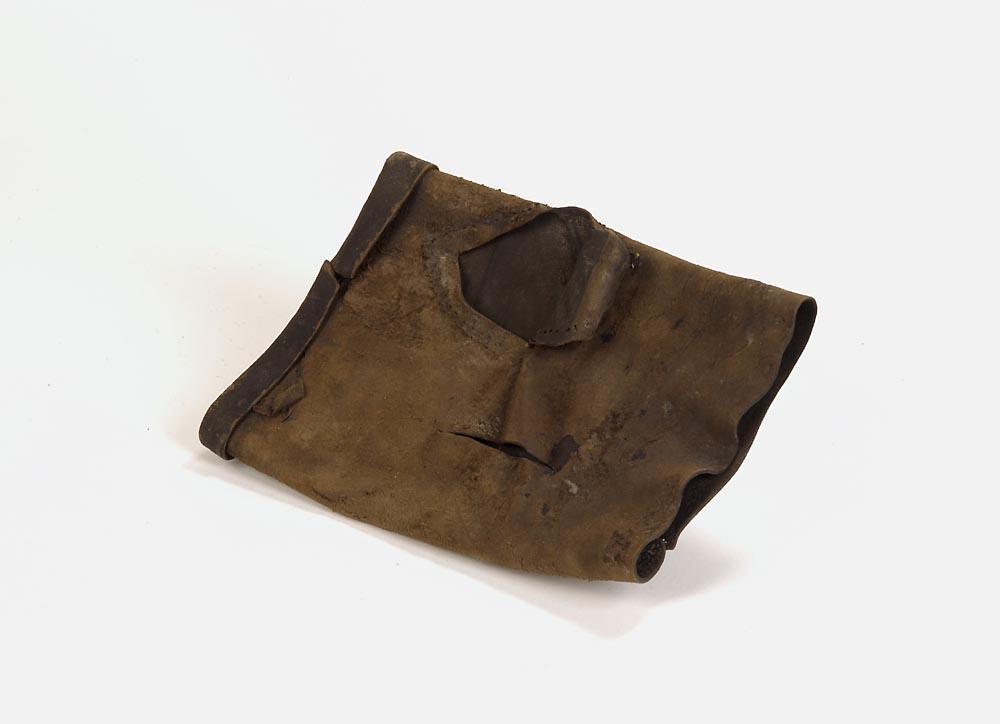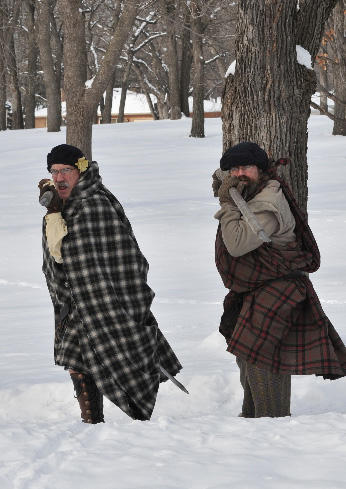Cold Weather Gear
Gaffneyis Regiment has been around for thirty-odd years now, but there is still a dearth of information about period winter clothing in our Manual. It is high time that we had some information published on period ways to stay warm. We are based in Minnesota, after all. Almost every year we see snow at an event at least once. Due to scant documentation for particularly Highland Scottish cold weather clothing, this list is supplemented by items from surrounding areas. I indicate to where each item is documented in the text. This is the first of a series on cold weather gear of the 17th century.
GENDER NEUTRAL ITEMS
Layers: sarks, coats, skirts, jackets, hose, etc. Wool sarks were sometimes worn over linen ones. One could wear britches or trews under the kilt. If not wearing one's plaid as a kilt, they were commonly worn about the shoulders as a cloak or mantle. Multiple petticotes (skirts). You get the idea. Or you could throw a blanket over your shoulders, as the poor fellow inthe foreground just left of center has in this winter scene by Avercamp, circa 1620. (Source).
Hoggers and Scoggers: knitted tubes which cover the forearm (scoggers) or lower leg (hoggers). Worn for warmth as well as to protect clothing from filth while working. They were considered low class, so they are perfect for us. Several 16th c English examples have been excavated in London, as well as one from the Mary Rose, sunk in 1545 (Rutt pp 63 - 65). Remember leg warmers? (ref. Ecc 1:9) They are so simple to make, even I have managed to do so.
Mittens: There is little written documentation for mittens between the Viking period and the late 18th c. This is perhaps due to their being too mundane to gain mention in the standard costume reference works, let alone primary documents. Fortunately, archaeology is filling in the lack. Here is a blog post with a variety of both mittens and gloves from our era. (Source).
Two leather mittens were recovered from the Mary Rose sunk in 1545 (source and source and source). They were found together in a chest, and were both for the left hand; why one man would have two left-handed mittens is anybody's guess. Here is another early 17th c English example with nice pierced decoration from the Met (source). A leather mitten with a nalbinding liner - the only single needle knit item ever found in the Netherlands - (Willemsen, p 80) and two knitted mittens were recovered from a foreign wreck dating to about 1660 found in the Netherlands (ibid. pp 75 - 79). The knitted mittens both had tar on them, so they were clearly worn by the mariners working the ship. The only other knitted mitten from our era ever found in the Netherlands is from the 16th c (Willemsen p 81). There is a great 16th c child's knitted mitten at the Museum of London (photo of original, its reproduction, as well as knitting instructions at source). And here are a couple sewn mittens from early 17th c wrecks in the Netherlands (source and source). Here is the only surviving Swedish example in nalbinding (single needle knitting) from the 16th or 17th c (source). Here is a reconstruction of a 17th c Polish mitten based upon one in an extant Polish tailor's pattern book (source). Denis Diderot published a pattern for men's sewn mittens in his Encyclopédie (published in 28 volumes from 1751 to 1772) which does not differ appreciably from mittens from our era (source)
Gloves, sewn: heavy leather gloves were popular with soldiers and certain craftspeople for protection in their work; lighter gloves, usually of a soft leather such as kid, were popular amongst the gentle and nobleclasses. Men's gloves, at least, were often gauntleted. As long fingers were considered attractive, on fashionable gloves the fingerswere often made extra long; the excess space was filled with wool or some such. Upper-class sewn gloves were often heavily embroidered, which is why so many survive. A more unusual glove is this early 17th c fingerless leather Dutch one. I suspect it was more for protecting the hand from wear and tear while handling, say, ship's ropes or fishing nets than for warmth. I cannot find the link to it in the Rijksmuseum, but at least I saved the jpg. See it at the end of this article.
Gloves, knit: Most surviving examples are either ecclesiastical or upper class, often with simulated finger rings knitted in a contrasting color. There are few extant knit gloves of which I am aware that are neither ecclesiastical nor upper class. Those of the Gunnister (Shetland) Manare at least from Scotland, but they are dated by coin evidence to sometime after 1690 (Henshall and Maxwell pp 35 - 36, plate VI). Based upon other evidence found with the body, the dead man was possibly a student or clerk (Henshall and Maxwell pp 41 - 42). There are a number of other extant versions from the early 17th c.
Hose, Sewn: generally wool, but sometimes linen, there were several varieties including footed, stirrup, and moggans, which were foot-less. Cut on the bias. Footed sewn hose were still standard military issue to Highland regiments in the British Army [and were still a common type for civilians] until well into the 19th century (Orr, p 220). Sewn hose were sometimes embroidered on the seams to strengthen them - the origin of clocked stockings.
Hose, Knitted: also were in use, although the finer the knitting, the more time consuming to make and, therefore, the more expensive the item. Even cheap knitted hose were considerably more expensive than sewn hose (a Massachusetts Bay Company list of 1628 prices sewn hose at 11 or 13pence/pair, while knitted hose went for 28 pence/pair - Rutt p 79, and Poppy finds a fairly consistent price range for cloth hose over time - 7to 22 pence per pair in 1578 to 6 to 26 pence in 1692, and the New Model Army paid between 12 and 22 pence per pair in the 1640s). They were many times more than that if made from silk instead of wool; Poppy notes a pair of silk stockings costing 19 shillings (that is 228 pence) in 1647. The conventional wisdom is that knitted hose - or knitted clothing in general, apart from caps - were not commonly worn in Scotland as they had a bias against knitted hose, seeing them as only fit for children and the elderly. The technique for knitting Argyle hose - knitted imitations of bias-cut tartan sewn hose - was not developed until the 19th c; knitted hose were solid colored. They often were knit (or evenembroidered) in imitation of sewn hose, with fake seams going up the back of the leg and marking where ankle gores would be on their sewn counterparts.
Socks: Extant versions of ankle socks include sewn linen fabric, knitted wool or silk, and a single surviving early 17th c wool example from Sweden done in nalbinding (single needle knitting).Heavy linen seems to have been the most common. These served double duty; in addition to providing an extra layer for warmth, they can also significantly increase the life of knitted stockings by cutting friction between stocking and shoe. There is a lower class example pictured in this circa 1570 painting from the Netherlands. Here is an extant pair of linen oversocks from 1612 Germany.
Contemporary depictions of soldiers in the British Civil War often show them apparently wearing two pair of hose; the outer ones are often quite baggy and are not gartered, so they bunch up about the ankle. There has been much disagreement on how to interpret the outer hose - they could, for example, simply be hoggers (see above). Different regiments of British Civil War reenactors, therefore, have different clothing guidelines in this regard.
Shoe Liners, sheepskin: The Manx sometimes attached a piece of sheepskin to the inside of their pampooties with pitch for warmth and comfort (McClintock p 129). The pitch would also help prevent the damp seeping in.
Shoe Liners, woolen: Stand on a piece of heavy scrap wool (e.g. an old blanket). As your feet change shape whether you are sitting or standing, have a friend draw the outline of your feet on the wool. Cut them out and insert into your shoes. You may wish to embroider an L and and R on them if your feet are more than a little dissimilar in size. These will help insulate your feet from the cold, cold ground.
Cap liners: Cap liners appear in 27 of the over 100 surviving knitted flat caps from 16th c England. They are typically a rough circle knitted in the round, ranging from 8.25" to about 14" in diameter, with an average diameter of about10". After fulling, these were stitched inside the flat caps with, possibly excepting a single example, the purl side facing the head. The surviving examples weigh from one to four ounces, with two ounces being the most common. These could also be cut from older flat caps which were overly-worn (Malcom-Davies, pp 63 - 65). Although to my knowledge, no cap liners surviving in Scotland, I see no good reason one could not put one in our caps.
Bibliography
(n.b. All links were live as of 4 March 2023.)
Diderot, Denis. Encyclopédie. Paris, 1751 - 1772. Online in several places.
Henshall, Audrey S. and Maxwell, Stuart. "Clothing and Other Articles from a Late 17th-Century Grave at Gunnister, Shetland". Proceedings of the Society of Antiquaries of Scotland, vol 86 pp 30 - 42 1952. In Clann Library, also online.
Kane, Maeve. "Spun, Measured, and Cut: Re-creating 17th Century Textiles and Fashion." Online at Spun, Measured and Cut. This is an old article by former member of the the Regiment.
Malcolm-Davies, Jane. "An Early Modern Mystery: A Pilot Study of Knitting, Napping and Capping." Archaeological Textiles Review, Vol 58, 2016, pp 57 - 74.
McClintock, H. F. Old Irish Dress and that of the Isle of Man. Dundalgan Press, Dundalk, Ireland 1950
Orr, Stewart. "Clothing Found on a Skeleton Discovered at Quintfall Hill, Barrock Estate, Near Wick." Proceedings of the Society of Antiquaries of Scotland, vol 55 pp 213 - 221, 1921.
Poppy, Pat. "Stockings in the 17th Century." 2017.
Rutt, Richard. History of Hand Knitting. Interweave Press, Loveland CO 2003
Willemsen, Annemarieke, "Two Knitted Mittens from a Seventeenth-Century Dutch Shipwreck." Archaeological Textiles Review, 2018, pp 75 - 82.


